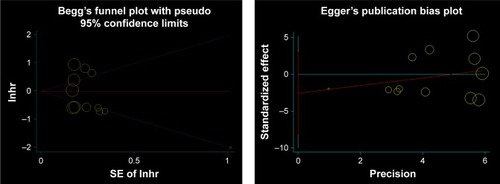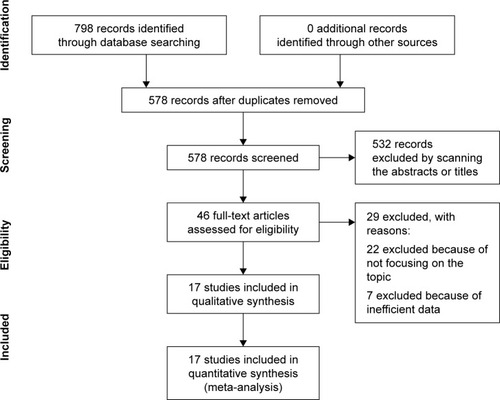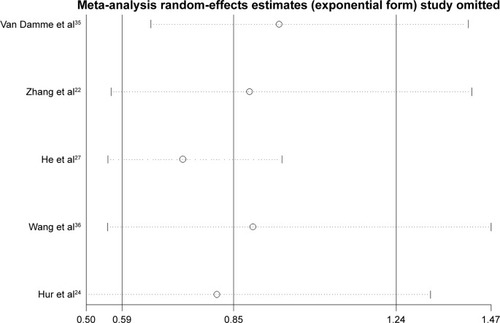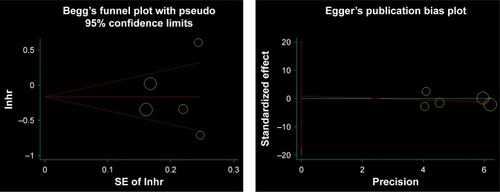Abstract
Background
Several studies have explored the prognostic value of sirtuin 3 (SIRT3) in various cancers, but obtained inconsistent results. The current systematic review and meta-analysis was conducted to investigate the association between SIRT3 expression and prognosis in various cancers.
Methods
PubMed, Embase, Web of Science and the Cochrane Library were comprehensively retrieved by the end of September 29, 2017. All the relevant studies were checked and included in the meta-analysis if they met the inclusion criteria.
Results
A total of 17 studies involving 2,865 patients were included in the systematic review and meta-analysis. The results indicated that SIRT3 expression was not significantly associated with overall survival (OS) (hazard ratio [HR]=0.87, 95% CI=0.59–1.29, P=0.50) and disease-free survival (HR=0.87, 95% CI=0.57–1.31, P=0.50) in total various cancers. However, significant relationship between SIRT3 expression and OS in specific cancers was detected, including chronic lymphocytic leukemia (CLL) (HR=0.48, 95% CI=0.26–0.89, P=0.019), hepatocellular carcinoma (HCC) (HR=0.56, 95% CI=0.42–0.74, P<0.001), pancreatic carcinoma (PC) (HR=0.55, 95% CI=0.30–1.00, P=0.049), renal cell carcinoma (RCC) (HR=0.13, 95% CI=0.02–0.98, P=0.048), breast cancer (BC) (HR=2.53, 95% CI=1.83–3.67, P<0.001), colon cancer (CC) (HR=1.87, 95% CI=1.12–3.26, P=0.022) and non-small-cell lung cancer (NSCLC) (HR=2.20, 95% CI=1.38–3.50, P=0.001). Moreover, SIRT3 expression was obviously associated with tumor size (odds ratio [OR]=1.41, 95% CI=1.02–1.94, P=0.04), tumor differentiation (OR=1.52, 95% CI=1.08–2.16, P=0.02) and clinical stage (OR=2.07, 95% CI=1.23–3.46, P=0.01) in HCC.
Conclusion
SIRT3 was distinctly related to the OS in specific cancers. SIRT3 was an unfavorable prognostic factor in BC, CC and NSCLC; however, it was also a favorable prognostic factor in CLL, HCC, PC and RCC, especially in HCC.
Introduction
Cancer is a major public health problem and the second leading cause of death in the US. It is estimated that 1,688,780 Americans will be newly diagnosed with cancers and 600,920 Americans will die from cancers in 2017.Citation1 Despite enormous progress has been made in the diagnosis and therapy, the ending of most cancer patients remains disappointing. In consideration of the current situation, the prognostic factors, able to predict the clinical outcomes and guide the therapy, are drawing a majority of researcher’s attention.Citation2–Citation9
Sirtuins, a family of NAD+-dependent deacetylases, regulate multiple signaling pathways’ cellular biology including cellular proliferation, metabolism, stress reaction and oxidation resistance.Citation10–Citation14 Seven isoforms of sirtuins (SIRT1–7) have been described in mammals. Among them, SIRT1 and SIRT2 are located preponderantly in the nucleus and cytosol, respectively. The remaining 3 sirtuins, SIRT3, SIRT4 and SIRT5, are located in the mitochondria.Citation15 Among this deacetylase family, SIRT3 is of particular interest. SIRT3 is synthesized as a 44 kDa peptide with an N-terminal sequence, which is the primary mitochondrial deacetylase and modulates the acetylation level of multiple mitochondrial proteins.Citation16 SIRT3 plays a critical role in various cellular activities, including cell proliferation, apoptosis and stress reaction.Citation15,Citation17 Owing to the important role of SIRT3 in cellular pathways, previous studies have testified that SIRT3 participated in the development of various diseases, such as diabetesCitation18 and myocardial injury.Citation19 In recent years, SIRT3 attracted researchers’ attention on account of its dual role in tumorigenesis.Citation10,Citation17,Citation20,Citation21 A great number of studies have been conducted to investigate the association between SIRT3 and tumorigenesis of various cancers, including hepatocellular carcinoma (HCC),Citation22 lung cancer,Citation23 gastric cancer (GC)Citation24 and breast cancer (BC).Citation25 However, the results were controversial. Zhang et alCitation22 collected 248 primary HCC specimens and found the patients with high SIRT3 expression tended to have longer overall survival (OS) compared to patients with low SIRT3 expression (hazard ratio [HR]=0.56, 95% CI=0.34–0.90, P=0.016). Similarly, Jeh et alCitation26 validated that renal cell carcinoma (RCC) patients with high SIRT3 expression had longer OS (HR=0.13, 95% CI=0.02–0.94, P=0.047). However, different observations were made in other studies. He et alCitation27 performed a study comprising 308 patients with BC to explore the correlation between SIRT3 expression and prognosis and unexpectedly found that BC patients with high SIRT3 expression possessed shorter OS compared to patients with low SIRT3 expression, which indicated that SIRT3 might reduce OS and be a unfavorable prognostic biomarker (HR=2.53, 95% CI=1.83–3.67, P<0.001). Coincidentally, the results of Yang et alCitation39 study reaffirmed the conclusion that SIRT3 might be a tumor promoter and could reduce the prognosis of cancer patients (HR=2.20, 95% CI=1.38–3.50, P=0.001). In view of the abovementioned controversial results, the dispute on the prognostic value of SIRT3 in various cancers spontaneously arises.
In view of the discrepancy, the current systematic review and meta-analysis was conducted to investigate the association between SIRT3 expression and prognosis in various cancers.
Materials and methods
Literature search strategy
PubMed, Embase, Web of Science and the Cochrane Library were comprehensively searched by the end of September 29, 2017. The search terms were as follows: “SIRT3”, “silent mating type information regulation 2 homolog 3”, “SIR2L3” OR “sirtuin 3” combining with “tumor”, “carcinoma” OR “cancer”. The references of the retrieved articles were also checked to avoid missing relevant studies.
Inclusion and exclusion criteria
The study would be included in this systematic review and meta-analysis if it met all the following criteria: 1) observational studies with cohorts; 2) investigating the relationship between SIRT3 expression and prognosis in various cancers; 3) covering treatment-free survival (TFS), recurrence-free survival (RFS), OS, disease-free survival (DFS), time to recurrence (TTR), cancer-specific survival (CSS) or clinicopathological parameters and 4) with full text. The exclusion criteria were as follows: duplicate publications, reviews, case reports, animal experiments, cell experiments and inefficient data.
Data extraction and quality assessment
An extraction template was designed in advance, and then 2 reviewers extracted the following data independently: the family name of the first author, publication year, country, ethnicity, sample size, the percentage of the male, the percentage of the patients with high SIRT3 expression level, cutoff value, clinical outcomes, cancer type and analysis model and information needed to evaluate the quality of each study. Any discrepancies during study selection and data extraction were resolved by discussion with the third reviewer. The HRs along with 95% CI obtained directly from published articles were integrated in the meta-analysis according to the study conducted by Tierney et al.Citation28 Two reviewers evaluated all the included studies independently after reading the full text of each study. The Newcastle–Ottawa scale (NOS) was utilized to assess the quality of the included studies.Citation29
Statistical analysis
All pooled analyses were conducted using Review Manager 5.3 (Cochrane Collaboration; UK) and STATA 12.0 software (StataCorp LP, College Station, TX, USA). For prognostic index, eg, OS, HR and corresponding 95% CI were used as the summary measure. For clinical parameters, dichotomous, the odds ratio (OR) and corresponding 95% CI were used to analyze the results. Chi-square test and I2 statistic were utilized to evaluate the interstudy heterogeneity. I2 equal to or less than 50% indicated that the heterogeneity was not statistically obvious, and the fixed-effect model was employed. If not, the random-effect model was applied. Begg’s test and Egger’s test conducted by STATA 12.0 were applied to assess the publication bias among the included studies. Sensitivity analysis performed by STATA 12.0 was applied to confirm the robustness of the results.
Results
Selection and characteristics of the included studies
This study complied with the Preferred Reporting Items for Systematic Reviews and Meta-Analyses for reporting systemic review and meta-analysis.Citation30 The process of literature search is shown in . In total, 798 papers were initially retrieved. Then, 578 papers remained when 220 duplicates were removed. Regarding the remaining 578 papers, titles or abstracts of them were screened and 532 were directly excluded for not concerning this topic. The full text of the remaining 46 papers was carefully read, and 29 papers were abandoned for the following reasons: 22 papers not focusing on this topic and 7 papers for inefficient data. Ultimately, 17 studies involving 2,865 patients were included into this systematic review and meta-analysis.Citation22–Citation27,Citation31–Citation41
The characteristics of included studies are presented in . Throughout these studies, 15 and 2 studies were carried out in Asian peopleCitation22–Citation24,Citation26,Citation27,Citation31–Citation34,Citation36–Citation41 and Caucasian people,Citation25,Citation35 respectively. Additionally, the sample size varied a lot among the included studies, from 30 to 350. In total, 15 studies reported the percentage of male, from 0% to 88.71%.Citation22–Citation27,Citation32–Citation34,Citation36–Citation41 Moreover, 15 studies illustrated the percentage of patients with high SIRT3 expression, varying from 25.81% to 60.00%.Citation22–Citation27,Citation31–Citation34,Citation36–Citation40 With respect to prognostic outcomes, 14 studies reported clinicopathological parameters,Citation22,Citation23,Citation25–Citation27,Citation31–Citation34,Citation36–Citation40 11 studies covered OS,Citation22,Citation24,Citation27,Citation31–Citation33,Citation35–Citation37,Citation39,Citation41 1 covered CSS,Citation26 2 reported DFS,Citation24,Citation27 1 covered RFS,Citation22 1 reported TFS and 1 covered TTR.Citation36 Furthermore, as for cancer type, 9 cancers were investigated, including chronic lymphocytic leukemia (CLL),Citation35 HCC,Citation22,Citation40 esophageal cancer (EC),Citation37,Citation41 GC,Citation31,Citation38 BC,Citation25,Citation27 colon cancer (CC),Citation33 pancreatic carcinoma (PC),Citation32 RCCCitation26 and non-small-cell lung cancer (NSCLC).Citation23,Citation39 In terms of analysis model, OS was analyzed using multivariate analysis in 10 studiesCitation22,Citation26,Citation27,Citation31–Citation33,Citation36,Citation37,Citation39,Citation41 and using univariate analysis in 2 studies.Citation24,Citation35 NOS used for evaluating quality of included studies varied from 5 to 8.
Table 1 Characteristics of the included studies
Meta-analysis of OS
A total of 11 studies covered the OS and 1 study presented CSS; hence, 12 studies containing 2,352 patients were involved in the meta-analysis of OS. As shown in , random-effect model was used for the evident heterogeneity (I2=89%). The results indicated that the SIRT3 expression was not significantly associated with OS (HR=0.87, 95% CI=0.59–1.29, P=0.50). The sensitivity analysis conducted by STATA 12.0 confirmed the robustness of the results (). Moreover, as shown in , no obvious publication bias was detected among included studies based on the results of Begg’s test (P=0.945) and Egger’s test (P=0.344).
Figure 2 Meta-analysis of OS.

Figure 4 Publication bias of OS based on Begg’s test and Egger’s test.

In view of the distinct heterogeneity of OS, the subgroup analysis was conducted to further explore the relationship between SIRT3 expression and various cancers. As shown in , the subgroup analyses were implemented based on analysis model, ethnicity, sample size and cancer type. Regarding analysis model, no statistically evident correlation was detected between SIRT3 expression neither when using multivariate analysis model (P=0.657) nor when using univariate analysis model (P=0.404). Similarly, there was no obvious relationship between SIRT3 expression and OS in cancer patients whether the sample size was greater (P=0.526) or less than 200 (P=0.698). Regarding the ethnicity, the results presented that patients with high SIRT3 expression might have obviously longer OS compared to patients with low SIRT3 expression in Caucasian (P=0.019); however, no relationship between SIRT3 expression and OS was observed in Asian (P=0.685). Furthermore, the subgroup analyses classified by cancer type validated that high SIRT3 expression was a favorable prognostic factor in patients with CLL (P=0.019), HCC (P<0.001), PC (P=0.049) and RCC (P=0.048). Nevertheless, the results also indicated that high SIRT3 expression was also an unfavorable prognostic factor in BC (P<0.001), CC (P=0.022) and NSCLC (P=0.001). In addition, there was no significant association between SIRT3 expression and OS in patients with EC (P=0.806) and GC (P=0.347).
Table 2 Subgroup analyses of OS
Meta-analysis of DFS
Among the 17 studies, 2 reported DFS, 1 covered RFS, 1 reported TFS and 1 covered TTR, and all these 5 studies were integrated into the meta-analysis of DFS. As shown in , the random-effect model was used for the distinct heterogeneity (I2=83%). The results demonstrated that there was no relationship between SIRT3 expression and DFS in patients with various cancers (HR=0.87, 95% CI=0.57–1.31, P=0.50). The sensitivity analysis tested the robustness of the results (). As shown in , there was no obvious publication bias among included studies based on the results of Begg’s test (P=1.000) and Egger’s test (P=0.901).
Meta-analysis of clinicopathological parameters
Among the included studies, 14 studies reported data about the relationship between SIRT3 expression and clinicopathological parameters, and the main clinicopathological parameters in this meta-analysis included age, sex, tumor size, tumor differentiation, clinical stage, vascular invasion, cirrhosis, alpha fetal protein (AFP) and hepatitis B virus (HBV) infection. As listed in , the results indicated that there was no significant relationship between SIRT3 expression and all abovementioned clinicopathological parameters. Now that significant association between SIRT3 expression and OS was observed in HCC patients, a subgroup analysis of clinicopathological parameters focusing on HCC patients was performed. The results demonstrated that HCC patients with high SIRT3 expression tended to be associated with smaller tumor size (OR=1.41, 95% CI=1.02–1.94, P=0.04; I2=46%), better tumor differentiation (OR=1.52, 95% CI=1.08–2.16, P=0.02; I2=50%) and earlier clinical stage (OR=2.07, 95% CI=1.23–3.46, P=0.01; I2=0%). However, no relationship was detected between SIRT3 expression and cirrhosis (P=0.71), and similar result was found in terms of AFP (P=0.48) and HBV infection (P=0.14) in HCC.
Table 3 Association between the SIRT3 expression level and clinicopathological parameters
Discussion
SIRT3, an arresting member of the sirtuins family located in mitochondria, plays a critical role in multiple cellular activities such as energy metabolism, cell proliferation and cell apoptosis.Citation11–Citation13,Citation15–Citation17 Recently, SIRT3 is gaining attention from more and more researchers due to its dual role in tumorigenesis.Citation22–Citation24,Citation26,Citation33–Citation41
In the current study, we validated that SIRT3 expression might not be related to the prognosis in various cancers, which was in accordance with the previous meta-analysis.Citation42 Regarding the subgroup analyses of OS, we found the high SIRT3 expression might be a favorable factor in Caucasian. However, it should be noted that only 1 study focusing on CLL was included into these subgroups; therefore, the conclusion was not quite unconvincing. It is worth mentioning that we noticed significant correlation between SIRT3 expression and prognosis in several specific cancers. The results manifested that SIRT3 might be a tumor suppressor in CLL, HCC, PC and RCC. Conversely, the results also indicated that SIRT3 might promote the cancer development and decrease the OS in patients with BC, CC or NSCLC. Meanwhile, no obvious relationship between SIRT3 expression and clinicopathological parameters in total various cancers was detected in the current study.
Yu et alCitation42 previously performed a meta-analysis involving 15 studies to explore the prognostic value of SIRT3 in various cancers and found no distinct relationship between SIRT3 expression and OS. Despite similar results, there were several differences between the current study and the previous meta-analysis.Citation42 First, in the previous meta-analysis, although the authors declared that 15 studies were included in the previous study, only 7 studies were analyzed in the meta-analysis of OS. The small population certainly reduced the convincing of the conclusion and restricted its clinical application. However, in the current study, 12 studies comprising 2,352 patients were involved in the meta-analysis of OS, and the results were clear and convincing. Second, Chinese databases such as China National Knowledge Infrastructure and Wanfang Data were searched in the previous studies, which might increase the selection bias in the previous meta-analysis. More importantly, 2 dissertations without peer-reviewed process were included into the previous meta-analysis, which decreases the persuasion of the conclusion to a great extent. Third, the quality assessment by NOS, the meta-analysis of DFS and the publication bias based on Begg’s test and Egger’s test were performed in the current meta-analysis, which was not reported in the previous meta-analysis. Hence, the methodology of the current study was more normative, and the conclusion could be drawn for enough credibility.
In spite of the numerous relative studies focusing on the prognostic role of SIRT3 in cancers, the underlying mechanism remains unclear. The complex mechanism might be on account of multiple biological roles of SIRT3 in cellular pathways, including cell proliferation, apoptosis and metabolism.Citation12,Citation17,Citation18,Citation43 In the current study, we discovered that SIRT3 functioned as a tumor suppressor or a tumor promoter in specific cancers, which indicated that SIRT3 might be involved with different signaling pathways in specific cancers. Regarding BC, Wei et alCitation44 focused on the association between cell metabolism and cancers, and they discovered that SIRT3 played a vital role in the BC cell proliferation, and the results indicated that oroxylin A inhibits glycolysis-dependent proliferation of BC cells through the suppression of HIF1α stabilization via SIRT3 activation. In addition, SIRT3 is absolutely necessary in the regulation of reactive oxygen species (ROS) production. Torrens-Mas et alCitation45 discovered that SIRT3 could be a therapeutic target for BC and improve the effectiveness of cisplatin (CDDP) and tamoxifen (TAM) treatments based on the ROS production. With regard to HCC, the study conducted by Liu et al found that the expression of SIRT3 was lower in HCC tissue than in non-HCC tissue, which manifested that SIRT3 was involved in the development of HCC and that SIRT3 acted as a tumor suppressor in HCC. Further in vitro experiments indicated that SIRT3 could inhibit the growth and proliferation of HepG2 cells and induce cell apoptosis,Citation46 which was consistent with our results. Similarly, Song et alCitation34 analyzed 60 HCC specimens and discovered that high SIRT3 expression was an unfavorable factor, and their further research validated that SIRT3 inhibited cell growth through the glycogen synthase kinase-3β/BCL2-associated X protein-dependent apoptotic pathway, which was in accordance with the viewpoint that the prognostic value of SIRT3 in specific cancers might be associated with the regulation of metabolism. In the current study, we also detected that HCC patients with high SIRT3 expression had longer OS, smaller tumor size, better tumor differentiation and earlier clinical stage compared to those with low SIRT3 expression. In view of the limited population, more studies should be carried out to ascertain the prognostic value of SIRT3 in HCC. Furthermore, other researchers testified that SIRT3 also acted as a tumor suppressor in RCC by regulating glutamine-derived mitochondrial respiration.Citation26,Citation47 Conversely, Liu et alCitation33 analyzed 127 patients with CC and discovered that patients with high SIRT3 expression had a better OS, which suggested that high SIRT3 expression was an unfavorable factor in CC, and similar result was observed in a study by Yan et al,Citation37 which found that high SIRT3 expression was associated with worse prognosis in EC. Taken together, despite the discrepancy, extensive studies have demonstrated that SIRT3 expression was significantly related to OS in specific cancers.
There are some highlights in the current study. First, a total of 2,865 patients were finally included into the meta-analysis and the conclusion was convincing enough. Second, comprehensive subgroup analyses of OS and clinicopathological parameters were performed to elucidate this issue, which increased clinical application value of the conclusion. Nevertheless, the current study was not without drawbacks. The cutoff values of SIRT3 expression varied a lot in some included studies. Hence, the clinical applicability of the conclusion was affected. In addition, the sample size of some subgroup analyses was relatively small, which might lower the influence of the results. Last but not least, the previous report did not show the detailed characteristics of various cancers, which might affect the reliability of the conclusion. Despite the abovementioned shortcomings, the current meta-analysis still gave more convincing evidence on the prognostic role of SIRT3 in various cancers and could help researchers to catch the important development in this filed.
Conclusion
There was no evident relationship between the SIRT3 expression and prognosis in total cancers. However, SIRT3 expression might be a critical prognostic factor in specific cancers, including CLL, HCC, BC, CC, PC, NSCLC and RCC, especially in HCC. More clinical cohort studies with large population size and strict methodology should be carried out to clarify the issues in future.
Acknowledgments
The study was supported by Science and Technology Development Fund of Nanjing Medical University (Key Project) (No 2017NJMUZD117).
Disclosure
The authors report no conflicts of interest in this work.
References
- SiegelRLMillerKDJemalACancer Statistics, 2017CA Cancer J Clin201767173028055103
- ChenSZhangLYanGNeutrophil-to-lymphocyte ratio is a potential prognostic biomarker in patients with ovarian cancer: a meta-analysisBiomed Res Int20172017794346728815182
- WangJZhaoYQiRPrognostic role of podocalyxin-like protein expression in various cancers: a systematic review and meta-analysisOncotarget2016832524575246428881743
- ZhaoYSiGZhuFPrognostic role of platelet to lymphocyte ratio in hepatocellular carcinoma: a systematic review and meta-analysisOncotarget2017814228542286228206965
- KimHMLeeJKooJSClinicopathological and prognostic significance of programmed death ligand-1 expression in breast cancer: a meta-analysisBMC Cancer201717169029041905
- LiNShiKKangXLiWPrognostic value of long non-coding RNA TUG1 in various tumorsOncotarget2017839656596566729029461
- WangCYangWDongFThe prognostic role of Sirt1 expression in solid malignancies: a meta-analysisOncotarget2017839663436635129029516
- WangJLiuYZhangNPrognostic role of pretreatment platelet to lymphocyte ratio in urologic cancerOncotarget2017841708747088229050328
- ZhouQHongLZuoMZHeZPrognostic significance of neutrophil to lymphocyte ratio in ovarian cancer: evidence from 4,910 patientsOncotarget2017840689386894928978169
- ChenYFuLLWenXSirtuin-3 (SIRT3), a therapeutic target with oncogenic and tumor-suppressive function in cancerCell Death Dis20145e104724503539
- BordoDStructure and evolution of human sirtuinsCurr Drug Targets201314666266523469873
- ChoiJEMostoslavskyRSirtuins, metabolism, and DNA repairCurr Opin Genet Dev201426243225005742
- LiYLiuTLiaoSA mini-review on sirtuin activity assaysBiochem Biophys Res Commun2015467345946626456653
- PirinenELo SassoGAuwerxJMitochondrial sirtuins and metabolic homeostasisBest Pract Res Clin Endocrinol Metab201226675977023168278
- AlhazzaziTYKamarajanPVerdinEKapilaYLSIRT3 and cancer: tumor promoter or suppressor?Biochim Biophys Acta201118161808821586315
- AhnBHKimHSSongSA role for the mitochondrial deacetylase Sirt3 in regulating energy homeostasisProc Natl Acad Sci U S A200810538144471445218794531
- XiongYWangMZhaoJHanYJiaLSirtuin 3: a Janus face in cancer (Review)Int J Oncol20164962227223527840909
- JingEEmanuelliBHirscheyMDSirtuin-3 (Sirt3) regulates skeletal muscle metabolism and insulin signaling via altered mitochondrial oxidation and reactive oxygen species productionProc Natl Acad Sci U S A201110835146081461321873205
- SundaresanNRSamantSAPillaiVBRajamohanSBGuptaMPSIRT3 is a stress-responsive deacetylase in cardiomyocytes that protects cells from stress-mediated cell death by deacetylation of Ku70Mol Cell Biol200828206384640118710944
- LeeDYJungDEYuSSLeeYSChoiBKLeeYCRegulation of SIRT3 signal related metabolic reprogramming in gastric cancer by Helicobacter pylori oncoprotein CagAOncotarget2017845783657837829108235
- AlhazzaziTYKamarajanPJooNSirtuin-3 (SIRT3), a novel potential therapeutic target for oral cancerCancer201111781670167821472714
- ZhangCZLiuLCaiMLow SIRT3 expression correlates with poor differentiation and unfavorable prognosis in primary hepatocellular carcinomaPLoS One2012712e5170323272146
- XiongYWangMZhaoJSIRT3 is correlated with the malignancy of non-small cell lung cancerInt J Oncol201750390391028197634
- HurHKimYBHamIHLeeDLoss of ACSS2 expression predicts poor prognosis in patients with gastric cancerJ Surg Oncol2015112658559126381042
- DesoukiMMDoubinskaiaIGiusDAbdulkadirSADecreased mitochondrial SIRT3 expression is a potential molecular biomarker associated with poor outcome in breast cancerHum Pathol20144551071107724746213
- JehSUParkJJLeeJSDifferential expression of the sirtuin family in renal cell carcinoma: aspects of carcinogenesis and prognostic significanceUrol Oncol20173512675.e9675.e15
- HeSHeCYuanHXiongSXiaoZChenLThe SIRT 3 expression profile is associated with pathological and clinical outcomes in human breast cancer patientsCell Physiol Biochem20143462061206925562154
- TierneyJFStewartLAGhersiDBurdettSSydesMRPractical methods for incorporating summary time-to-event data into meta-analysisTrials200781617555582
- StangACritical evaluation of the Newcastle-Ottawa scale for the assessment of the quality of nonrandomized studies in meta-analysesEur J Epidemiol201025960360520652370
- MoherDLiberatiATetzlaffJAltmanDGPRISMA GroupPreferred reporting items for systematic reviews and meta-analyses: the PRISMA statementPLoS Med200967e100009719621072
- HuangKHHsuCCFangWLSIRT3 expression as a biomarker for better prognosis in gastric cancerWorld J Surg201438491091724322174
- HuangSChenXZhengJLow SIRT3 expression contributes to tumor progression, development and poor prognosis in human pancreatic carcinomaPathol Res Pract2017213111419142328867266
- LiuCHuangZJiangHShiFThe sirtuin 3 expression profile is associated with pathological and clinical outcomes in colon cancer patientsBiomed Res Int2014201487126325105144
- SongCLTangHRanLKSirtuin 3 inhibits hepatocellular carcinoma growth through the glycogen synthase kinase-3β/BCL2-associated X protein-dependent apoptotic pathwayOncogene201635563164125915842
- Van DammeMCrompotEMeulemanNHDAC isoenzyme expression is deregulated in chronic lymphocytic leukemia B-cells and has a complex prognostic significanceEpigenetics20127121403141223108383
- WangJXYiYLiYWDown-regulation of sirtuin 3 is associated with poor prognosis in hepatocellular carcinoma after resectionBMC Cancer20141429724774224
- YanSMHanXHanPJChenHMHuangLYLiYSIRT3 is a novel prognostic biomarker for esophageal squamous cell carcinomaMed Oncol201431810325005846
- YangBFuXShaoLDingYZengDAberrant expression of SIRT3 is conversely correlated with the progression and prognosis of human gastric cancerBiochem Biophys Res Commun2014443115616024287180
- YangGCFuBCZhangDYThe expression and related clinical significance of SIRT3 in non-small-cell lung cancerDis Markers20172017824195328947845
- ZhangBQinLZhouCJLiuYLQianHXHeSBSIRT3 expression in hepatocellular carcinoma and its impact on proliferation and invasion of hepatoma cellsAsian Pac J Trop Med20136864965223790338
- ZhaoYYangHWangXZhangRWangCGuoZSirtuin-3 (SIRT3) expression is associated with overall survival in esophageal cancerAnn Diagn Pathol201317648348523871415
- YuFYXuQWuDDLauATXuYMThe prognostic and clinicopathological roles of sirtuin-3 in various cancersPLoS One2016118e015980127483432
- HaigisMCDengCXFinleyLWKimHSGiusDSIRT3 is a mitochondrial tumor suppressor: a scientific tale that connects aberrant cellular ROS, the Warburg effect, and carcinogenesisCancer Res201272102468247222589271
- WeiLZhouYQiaoCOroxylin A inhibits glycolysis-dependent proliferation of human breast cancer via promoting SIRT3-mediated SOD2 transcription and HIF1α destabilizationCell Death Dis20156e171425855962
- Torrens-MasMPonsDGSastre-SerraJOliverJRocaPSIRT3 silencing sensitizes breast cancer cells to cytotoxic treatments through an increment in ROS productionJ Cell Biochem2017118239740627420645
- LiuYLiuYLChengWYinXMJiangBThe expression of SIRT3 in primary hepatocellular carcinoma and the mechanism of its tumor suppressing effectsEur Rev Med Pharmacol Sci201721597899828338198
- ChoiJKohELeeYSMitochondrial Sirt3 supports cell proliferation by regulating glutamine-dependent oxidation in renal cell carcinomaBiochem Biophys Res Commun2016474354755327114304





